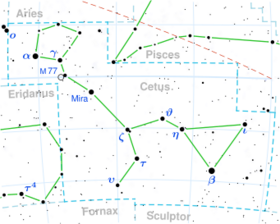Astronomy:Nu Ceti
| Observation data Equinox J2000.0]] (ICRS) | |
|---|---|
| Constellation | Cetus |
| Right ascension | 02h 35m 52.473s[1] |
| Declination | +05° 35′ 35.69″[1] |
| Apparent magnitude (V) | 4.86[2] + 9.08[3] (visual companion) |
| Characteristics | |
| Spectral type | G8III + F7V (visual companion)[4] |
| U−B color index | 0.52[2] |
| B−V color index | 0.88[2] |
| Astrometry | |
| Radial velocity (Rv) | 4.81±0.02[5] km/s |
| Proper motion (μ) | RA: −26.51±0.25[1] mas/yr Dec.: −22.32±0.22[1] mas/yr |
| Parallax (π) | 9.59 ± 0.23[1] mas |
| Distance | 340 ± 8 ly (104 ± 3 pc) |
| Absolute magnitude (MV) | −0.415[6] |
| Orbit[5] | |
| Primary | ν Ceti A |
| Period (P) | 714.48±0.15 days |
| Eccentricity (e) | 0.274±0.005 |
| Periastron epoch (T) | 53364.9±1.9 |
| Argument of periastron (ω) (secondary) | 119.5±1.1° |
| Semi-amplitude (K1) (primary) | 5.09±0.03 km/s |
| Details | |
| Aa | |
| Mass | 2.65[7] M☉ |
| Radius | 15.87+1.06 −2.19[8] R☉ |
| Luminosity | 161.4±7.9[8] L☉ |
| Surface gravity (log g) | 2.56[7] cgs |
| Temperature | 5,164+417 −164[8] K |
| Age | 537[7] Myr |
| Other designations | |
| Database references | |
| SIMBAD | data |
ν Ceti, Latinized as Nu Ceti, is a binary star[5] system in the equatorial constellation of Cetus. It is visible to the naked eye as a faint point of light with a combined apparent visual magnitude of 4.86.[2] The system is located approximately 340 light years distant from the Sun, based on parallax, and is drifting further away with a radial velocity of 4.8 km/s.[5] Nu Ceti is believed to be part of the Ursa Major stream of co-moving stars.[10]
In Chinese, 天囷 (Tiān Qūn), meaning Circular Celestial Granary, refers to an asterism consisting of α Ceti, κ1 Ceti, λ Ceti, μ Ceti, ξ1 Ceti, ξ2 Ceti, ν Ceti, γ Ceti, δ Ceti, 75 Ceti, 70 Ceti, 63 Ceti and 66 Ceti. Consequently, the Chinese name for ν Ceti itself is "the Seventh Star of Circular Celestial Granary", Tiān Qūn Qī.[11]
The primary, designated component A, forms a single-lined spectroscopic binary with an orbital period of 1.96 years and an eccentricity of 0.27.[5] The visible component is a G-type giant star, currently on the horizontal branch,[7] with a stellar classification of G8III.[4] In addition to the spectroscopic companion there is a visual companion star which shares a common proper motion with Nu Ceti A, designated component B; an F-type main-sequence star with a class of F7V[4] and a 9.08 apparent visual magnitude located 8.0 arcsec away. It was discovered by Struve.[5][3]
References
- ↑ 1.0 1.1 1.2 1.3 1.4 van Leeuwen, F. (2007). "Validation of the new Hipparcos reduction". Astronomy and Astrophysics 474 (2): 653–664. doi:10.1051/0004-6361:20078357. Bibcode: 2007A&A...474..653V. http://www.aanda.org/articles/aa/full/2007/41/aa8357-07/aa8357-07.html. Vizier catalog entry
- ↑ 2.0 2.1 2.2 2.3 Cousins, A. W. J. (1963). "Photometric Data for Stars in the Equatorial Zone (Third List)". Monthly Notes of the Astronomical Society of Southern Africa 22: 12–17. Bibcode: 1963MNSSA..22...12C. http://articles.adsabs.harvard.edu/full/1963MNSSA..22...12C.
- ↑ 3.0 3.1 Lutz, T. E.; Lutz, J. H. (1977). "Spectral classification and UBV photometry of bright visual double stars". The Astronomical Journal 82: 431–434. doi:10.1086/112066. Bibcode: 1977AJ.....82..431L. http://articles.adsabs.harvard.edu/full/1977AJ.....82..431L.
- ↑ 4.0 4.1 4.2 Stephenson, C. B.; Sanwal, N. B. (1969). "The masses of stars above the main sequence". The Astronomical Journal 74: 689–704. doi:10.1086/110845. Bibcode: 1969AJ.....74..689S. http://articles.adsabs.harvard.edu/full/1969AJ.....74..689S.
- ↑ 5.0 5.1 5.2 5.3 5.4 5.5 Griffin, R. F. (2015). "Spectroscopic binary orbits from photoelectric radial velocities. Paper 240: BD+59 224, HD 9592, HD 10171, HD 11738, and nu Ceti". The Observatory 135: 15–41. Bibcode: 2015Obs...135...15G. http://articles.adsabs.harvard.edu/full/2015Obs...135...15G.
- ↑ "Nu Ceti". http://www.astrostudio.org/xhip.php?hip=12093.
- ↑ 7.0 7.1 7.2 7.3 Stock, Stephan et al. (August 2018), "Precise radial velocities of giant stars. X. Bayesian stellar parameters and evolutionary stages for 372 giant stars from the Lick planet search", Astronomy & Astrophysics 616: 15, doi:10.1051/0004-6361/201833111, A33, Bibcode: 2018A&A...616A..33S.
- ↑ 8.0 8.1 8.2 Brown, A. G. A. (August 2018). "Gaia Data Release 2: Summary of the contents and survey properties". Astronomy & Astrophysics 616: A1. doi:10.1051/0004-6361/201833051. Bibcode: 2018A&A...616A...1G. Gaia DR2 record for this source at VizieR.
- ↑ "nu. Cet". SIMBAD. Centre de données astronomiques de Strasbourg. http://simbad.u-strasbg.fr/simbad/sim-basic?Ident=nu.+Cet.
- ↑ Levato, H.; Abt, H. A. (August 1978), "Spectral types in the Ursa Major stream", Publications of the Astronomical Society of the Pacific 90: 429−433, doi:10.1086/130352, Bibcode: 1978PASP...90..429L.
- ↑ (in Chinese) AEEA (Activities of Exhibition and Education in Astronomy) 天文教育資訊網 2006 年 7 月 11 日
External links
- http://server3.wikisky.org/starview?object_type=1&object_id=1566
- http://www.alcyone.de/SIT/bsc/HR0754.html
 |


